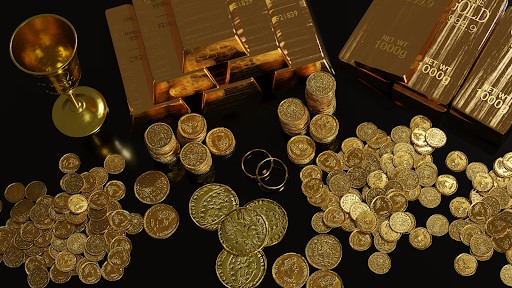What are the different gold alloys?
Alloying gold: the complete guide
When you’re looking to buy a piece of gold jewelry, you may find yourself baffled by the variety of colors available! With a gold alloy, you can obtain many shades more or less close to the classic golden hue. In this article, we take a look at the different gold colors and alloys available, both natural and artificial.
Are there different types of gold?
Solid gold
This is the gold referred to when mentioning the definition of gold. It is commonly used in rings, bands, watches and earrings. Measured in carats, it determines the purity of the metal.ounce of gold Pure gold is 24 carats, while alloys can be 18, 14 or 9 carats. With solid gold, gold alloying can improve the strength and durability of the precious metal. Solid gold is often preferred for its purity and strength.
Filled gold
Filled gold means that the object is not entirely made of gold. Composed of a metal base covered with 9- or 10-gold. 14-carat goldthe proportion of gold must be 5% of the total weight of the object. The carat marking indicates only the quantity of gold in the surface layer.
Gold vermeil
Gold vermeil is similar to filled gold, but with a sterling silver base. The thickness of the gold layer is different from that of filled gold. It is a more fragile metal, requiring special care to avoid scratches. Filled gold and vermeil offer the appearance of gold at a reduced cost.
Gold plating
Plated gold consists of a thin layer of gold deposited on a metallic base (such as copper, silver or brass). The plating process is carried out electrochemically. Less durable than other types, it damages more easily over time and gradually loses its brilliance. Plated gold is generally the least expensive, but it is also the most susceptible to wear.

Natural gold alloys
A natural gold alloy comprises combinations of metals found in nature in different proportions. Here are some of these alloys:
- Electrum: a natural alloy of gold and silver, electrum has its roots in ancient Greece and is mentioned in the Odyssey. It is known for its high reflectivity and thermal and electrical conductivity. It is also malleable, yet resistant to corrosion and oxidation.
- Porpézite: this natural alloy consists mainly of gold and palladium, but can sometimes contain silver. Commonly used in dentistry and watchmaking, porpezite shares with electrum the quality of being an excellent conductor of electricity.
- Rhodite: a natural alloy of gold and rhodium. Rhodite can vary greatly in metallic composition. Native to Mexico and Colombia, this gold alloy is used in jewelry for its extreme resistance, inalterability and high reflectivity.
- Amalgam: composed of gold and mercury, and sometimes a small amount of silver, amalgam was once used to separate gold from ore. Today, it is strictly forbidden due to its toxicity, but it remains an example of a natural alloy with historical applications.
These alloys illustrate the diversity and complexity of metallic combinations that can be found in nature, each with unique properties and uses!
Gold alloy, an option for coloring gold jewelry
Gold alloy in jewelry
In the jewelry industry, the use of alloys is essential. Pure gold is too soft and brittle to be used on its own, so jewelers mix gold with other metals to create alloys. A gold alloy gives jewelry greater strength and durability, and also offers the possibility of changing the color of the gold.
Gold alloys in jewelry don’t just improve the strength of pieces. They also add a dimension of personalization and beauty. The ability to play with the color of gold through various alloys enables jewelry designers to produce unique and varied works, tailored to individual tastes and preferences.

Gold colors
Among the various colors of gold alloys are :
- Yellow gold: obtained by mixing gold with copper and silver. The caratage varies according to the proportions of these metals, offering hues of 22, 18, 14 and 9 carats.
- White gold and white gold: these alloys are often created with rhodium, which whitens the gold, turning it gray or white. They are available in several caratages, such as 20, 18, 14 and 9 carats.
- Rose and red gold: the presence of copper determines the color, with more copper giving a redder hue. Proportions vary according to caratage and also include silver.
- Green gold: this blend of gold and silver offers reflections ranging from yellow to green. It is available in 18 and 14 carat, with various compositions that sometimes include copper and zinc.
- Black gold: uncommon, it can be created from white gold or a heat-treated alloy of gold and cobalt. 18-carat black gold also requires surface treatment with black rhodium.
- Blue gold: composed of 75% gold, iron and nickel, this alloy requires heat treatment to obtain its color. It is also available in 11-carat with indium.
- Violet gold: known for its fragility, this color is often used for inlay. It contains 79% gold and 21% aluminum.
Where to buy gold and gold jewelry?
Les Métaux Précieux can help you with all your gold and jewelry projects.buying and selling gold. We offer a wide range of gold coins and bars. Our experts use real-time gold prices to estimate your gold transaction. gold buy-back or jewelry buyback.
If you have jewelry for sale, coins or ingots, our experts will estimate your gold objects free of charge and without obligation, always with the aim of giving you a fair price in line with the market price.